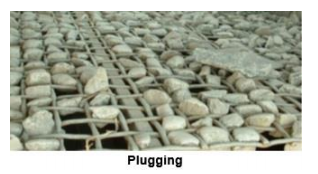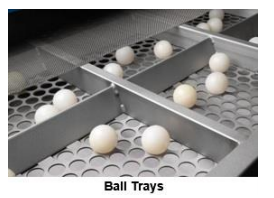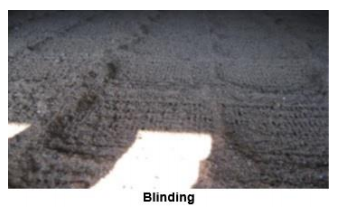

As shown in above figure, the ball trays consist of compartments with perforated plate or wire cloth with relatively large openings placed beneath the screen cloth. Generally, rubber balls are placed in each compartment that freely bounce during the operation of the screen. They strike the underside of the screen surface and therefore randomly knock out the clogged material. The secondary vibration generated in the screen cloth due to striking of the balls also prevents fine particles from sticking and building up on the wires. In most cases, a ball tray will be effective with material containing as much as 5% moisture. The material that passes through the screen cloth passes through the perforated plate or wire cloth at the bottom of the ball tray where it can be collected.
Ball trays are generally used for coarse meshes which can withstand higher impact energy from the balls. Balls are not recommended for fine screen meshes because they may damage the screen cloth.

As a rule of thumb, screening at less than around 5 mm aperture size must be performed on perfectly dry or wet material, unless special measures are taken to prevent blinding. Blinding occurs when moisture causes fine particles to stick to the surface and gradually cover the openings. In this case, changing stroke and increasing speed may help. Use of different surface media also may be considered. The other options are to consider ball trays and heated decks. Heated decks have an electric current in the wire that heats and dries the material so that it easily knocks itself loose as the screen vibrates. Heated deck is a more effective method of preventing blinding in damp materials (1.5 to 6% moisture) than the ball tray.
Heating transformers, consuming from 2 to 3 KVA per foot of screen length, can be used with any screen cloth weighing less than about 1.5 lbs. per square foot. The current flows at a low voltage (1 to 12) and a high amperage to produce temperatures on the screen wires ranging from 80 to 150°F. This heat is not intended to dry the material being screened, but only to dry the interface between the wire and adhering particles (e.g. clay particles) sufficiently to break the adhesive bond holding the particles to the wire. The screen vibration does the rest.
Wet screening allows finer sizes to be processed efficiently down to 250 μm and finer.
Adherent fines are washed off large particles, and the screen is cleaned by the flow of pulp and additional water sprays. Carryover occurs when excessive undersize particles fail to pass through the openings. Solutions may involve changing stroke, speed or reversing screen rotation; changing wire diameter or the shape of the opening to increase open area; changing the angle of inclination and changing feed tonnage.
call us :
e-mail : sales@vrvibratory.com